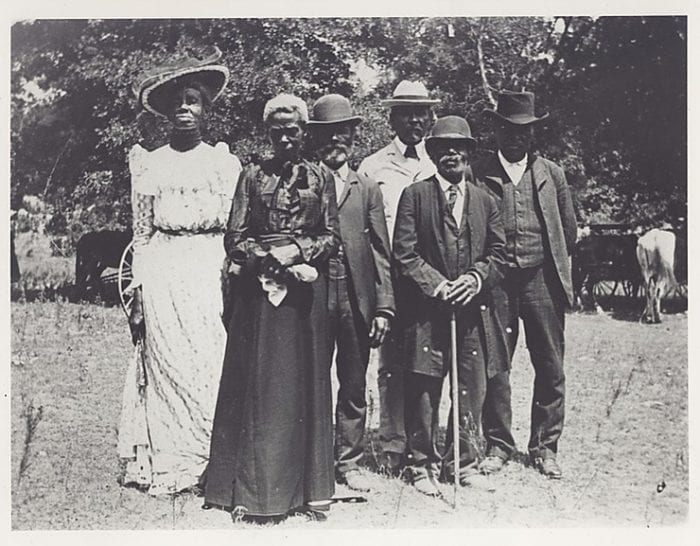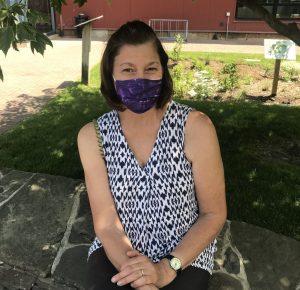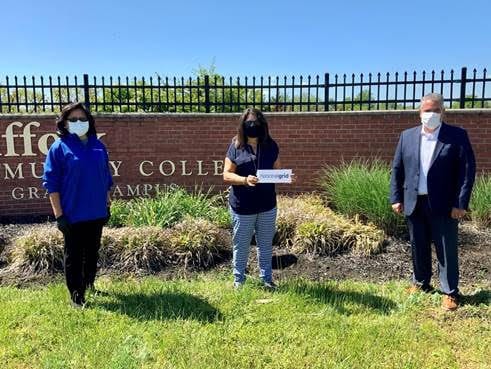SUMMER TIDE
Elyse Buchman snapped this peaceful scene in her hometown of Stony Brook on June 14 while having a sunset dinner with her husband at the Hercules Pavilion.
Send your photo of the week to [email protected]
SUMMER TIDE
Elyse Buchman snapped this peaceful scene in her hometown of Stony Brook on June 14 while having a sunset dinner with her husband at the Hercules Pavilion.
Send your photo of the week to [email protected]

This article originally appeared on the Three Village Historical Society website and is reprinted with permission.
By Tara Ebrahimian
Juneteenth, first established by the Black community of Texas in 1866, is now getting in New York State the recognition it has long deserved. On June 17, 2020 Governor Andrew M. Cuomo announced that he would, by Executive Order, recognize Juneteenth as a state holiday, and put it before the New York legislature to make this mandate, law. Although Juneteenth began in the South, it is widely observed throughout the country. It is annually observed in New York, including on Long Island, through independent and collaborative celebrations. Juneteenth’s historic and cultural relevance impacts the entire nation and remains hugely significant for Black heritage and United States history.
It commemorates June 19, 1865, when enslaved Blacks learned that they were legally free. Union Army General Gordon Granger arrived with his troops in Galveston, Texas, and made a profound announcement: the war and slavery were over. Technically the war ended when General Robert E. Lee surrendered on April 9, 1865, and the Emancipation Proclamation, effective January 1, 1863, freed enslaved persons in Confederate states, but the news had not been shared in Texas. It was the last stronghold of slavery. Since 1862, when New Orleans was captured, slave owners from Mississippi, Louisiana, and other southern states had moved with their slaves to Texas. There were approximately 250,000 enslaved people residing in Texas when the declaration was made.
Granger’s delivery of the news did not result in an immediate end of slavery. Blacks in Galveston initially celebrated the revelation, but the mayor contradicted the law and forced them to go back to work. It was largely left to the slave owners’ discretion whether they informed individuals that they were no longer enslaved. Many did not initially share the information and instead waited for the arrival of a government agent to tell them. Blacks were frequently not informed until after the harvest. A number of newly emancipated individuals ignored the censure to stay put and left for Arkansas, Louisiana, and Oklahoma. They did so at their own risk; there were numerous reports of Blacks being lynched as they tried to leave.
In 1866 freed people in Texas, in conjunction with the Freedmen’s Bureau, organized formal celebrations for “Jubilee Day.” During the years immediately after the war, Jubilee Day was sometimes celebrated on January 1st, a reference to the enactment of the Emancipation Proclamation. It also functioned as a rally for political and social advancement; Jubilee Day frequently offered instruction for voter registration and participation. The day became a mainstream event in Black communities and featured festivities, activities, and food.
Segregation in cities prohibited Blacks from going to public parks. Church grounds were often used as sites for the events. And, freed individuals pooled money to purchase land on which to hold celebrations. For example, Black community leaders, led by Reverend Jack Yates, raised $1000 in 1872 to purchase land that is now Houston’s Emancipation Park. These annual celebrations began drawing thousands of participants throughout Texas and expanding beyond the state. By the end of the century, Jubilee Day was known primarily as Juneteenth.
During this period, many southern states enacted punitive and punishing Jim Crow legislation that undermined or undid the economic and political progress Blacks had made during and after Reconstruction. These local and state laws were designed to subjugate and stymie Black social, economic, and political development. They disenfranchised Black people through segregation and policies such as the Grandfather Clause that limited or eliminated voting rights.
Many freed people left Texas and the South in search of greater opportunities in the North. Juneteenth was a still Southern celebration and attendance outside of Texas began to wane. Younger generations, more removed from the war and seeking to distance themselves from the legacy of slavery, also started to distance themselves from participating in the unofficial holiday. As the twentieth century progressed, and people moved from agricultural to industrial employment, it was increasingly unlikely that people would be granted time off work for Juneteenth. The Great Depression, in particular, caused a migration from the country to the cities.
The Civil Rights movement caused a resurgence in awareness about Juneteenth. Black youth joined their elders in the fight for Civil Rights. There was increased interest in and engagement with history and how the past informs the present. The Poor People’s March to Washington, D.C. served as a catalyst for renewed interest in Juneteenth. Participants returned to their home states and initiated Juneteenth celebrations in locations that had never before experienced them.
In 1980, Texas was the first state to formally recognize Juneteenth; it declared the date a “holiday of significance…” At the end of the decade, California, Illinois, Wisconsin, Georgia, and Washington, D.C., were among the places that presented major events for Juneteenth. Although Congress has remembered Juneteenth in different ways over the years, it is not yet a national holiday. In New York, “Juneteenth Freedom Day” was first identified as a commemorative holiday in 2004, per a state law signed by Governor George Pataki.
Long Island hosts a growing number of events and programs dedicated to this occasion. Frequently celebrated on the third Sunday in June, modern events share certain traits with their predecessors, including picnics, cookouts, historical reenactments, street fairs, parades, etc. This year’s festivities are scaled back due to COVID-19, but certain celebrations, such as the Long Island Unity March on June 19, were still scheduled.
Author Tara Ebrahimian is the Education Coordinator at the Three Village Historical Society in Setauket — www.tvhs.org.

By David Dunaief, M.D.

Wherever you look there is an advertisement for the treatment of heartburn or indigestion, both of which are related to reflux disease.
Reflux typically results in symptoms of heartburn and regurgitation, with stomach contents going backward up the esophagus. For some reason, the lower esophageal sphincter, the valve between the stomach and esophagus, inappropriately relaxes. No one is quite sure why it happens with some people and not others. Of course, a portion of reflux is physiologic (normal functioning), especially after a meal (1). As such, it typically doesn’t require medical treatment.
Gastroesophageal reflux disease (GERD), on the other hand, differs in that it’s long-lasting and more serious, affecting as much as 28 percent of the U.S. population (2). Can you understand why pharmaceutical firms give it so much attention?
GERD risk factors are diverse. They range from lifestyle — obesity, smoking cigarettes and diet — to medications, like calcium channel blockers and antihistamines. Other medical conditions, like hiatal hernia and pregnancy, also contribute (3). Diet issues include triggers like spicy foods, peppermint, fried foods and chocolate.
Smoking and Salt
One study showed that both smoking and salt consumption added to the risk of GERD significantly (4). Risk increased 70 percent in people who smoked. Surprisingly, people who used table salt regularly saw the same increased risk as seen with smokers.
Medications
The most common and effective medications for the treatment of GERD are H2 receptor blockers (e.g., Zantac and Tagamet), which partially block acid production, and proton pump inhibitors (e.g., Nexium and Prevacid), which almost completely block acid production (5). Both classes of medicines have two levels: over-the-counter and prescription strength. Here, I will focus on PPIs, for which more than 100 million prescriptions are written every year in the U.S. (6).
The most frequently prescribed PPIs include Prilosec (omeprazole), Protonix (pantoprazole), Nexium (esomeprazole), and Prevacid (lansoprazole). They have demonstrated efficacy for short-term use in the treatment of Helicobacter pylori-induced (bacteria overgrowth in the gut) peptic ulcers, GERD symptoms and complication prevention and gastric ulcer prophylaxis associated with NSAID use (aspirin, ibuprofen, etc.) as well as upper gastrointestinal bleeds.
However, they are often used long-term as maintenance therapy for GERD. PPIs used to be considered to have mild side effects. Unfortunately, evidence is showing that this may not be true. Most of the data in the package inserts is based on short-term studies lasting weeks, not years. The landmark study supporting long-term use approval was only one year, not 10 years. However, maintenance therapy usually continues over many years.
Side effects that have occurred after years of use are increased risk of bone fractures and calcium malabsorption; Clostridium difficile, a bacterial infection in the intestines; potential vitamin B12 deficiencies; and weight gain (7).
Bacterial infection risks
The FDA warned that patients who use PPIs may be at increased risk of a bacterial infection called C. difficile. This is a serious infection that occurs in the intestines and requires treatment with antibiotics. Unfortunately, it only responds to a few antibiotics and that number is dwindling. In the FDA’s meta-analysis, 23 of 28 studies showed increased risk of infection. Patients need to contact their physicians if they develop diarrhea when taking PPIs and the diarrhea doesn’t improve (8).
B12 deficiencies
Suppressing hydrochloric acid produced in the stomach may result in malabsorption issues if turned off for long periods of time. In a study where PPIs were associated with B12 malabsorption, it usually took at least three years’ duration to cause this effect. B12 was not absorbed properly from food, but the PPIs did not affect B12 levels from supplementation (9). Therefore, if you are taking a PPI chronically, it is worth getting your B12 and methylmalonic acid (a metabolite of B12) levels checked and discussing possible supplementation with your physician if you have a deficiency.
Lifestyle modifications
A number of modifications can improve GERD, such as raising the head of the bed about six inches, not eating prior to bedtime and obesity treatment, to name a few (10). In the same study already mentioned with smoking and salt, fiber and exercise both had the opposite effect, reducing the risk of GERD (5). This was a prospective (forward-looking) trial. The analysis by Journal Watch suggests that the fiber effect may be due to its ability to reduce nitric oxide production, a relaxant for the lower esophageal sphincter (11).
Obesity
In one study, obesity exacerbated GERD. What was interesting about the study is that researchers used manometry, which measures pressure, to show that obesity increases the pressure on the lower esophageal sphincter significantly (12). Intragastric (within the stomach) pressures were higher in both overweight and obese patients on inspiration and on expiration, compared to those with normal body mass index. This is yet another reason to lose weight.
Eating close to bedtime
Though it may be simple, it is one of the most powerful modifications we can make to avoid GERD. A study that showed a 700 percent increased risk of GERD for those who ate within three hours of bedtime, compared to those who ate four hours or more prior to bedtime. Of note, this is 10 times the increased risk of the smoking effect (13). Therefore, it is best to not eat right before bed and to avoid “midnight snacks.”
Although there are a number of ways to treat GERD, the most comprehensive have to do with modifiable risk factors. Drugs have their place in the arsenal of choices, but lifestyle changes are the first — and most effective — approach in many instances. Consult your physician before stopping PPIs, since there may be rebound hyperacidity (high acid produced) if they are stopped abruptly.
References:
(1) Gastroenterol Clin North Am. 1996;25(1):75. (2) Gut. 2014 Jun; 63(6):871-80. (3) emedicinehealth.com. (4) Gut 2004 Dec.; 53:1730-1735. (5) Gastroenterology. 2008;135(4):1392. (6) Proton Pump Inhibitor, ClinCalc DrugStats Database, Version 20.0. Updated December 23, 2019. Accessed June 23, 2020. (7) World J Gastroenterol. 2009;15(38):4794–4798. (8) www.FDA.gov/safety/medwatch/safetyinformation. (9) Linus Pauling Institute; lpi.oregonstate.edu. (10) Arch Intern Med. 2006;166:965-971. (11) JWatch Gastro. Feb. 16, 2005. (12) Gastroenterology 2006 Mar.; 130:639-649. (13) Am J Gastroenterol. 2005 Dec.;100(12):2633-2636.
Dr. David Dunaief is a speaker, author and local lifestyle medicine physician focusing on the integration of medicine, nutrition, fitness and stress management. For further information, visit www.medicalcompassmd.com.
MEET COOKIE!
This week’s shelter pet is Cookie, an eight-year-old female Terrier mix from the Smithtown Animal Shelter who is destined to bring love and happiness to one lucky family.
With a puppy-like demeanor, a lapdog mentality and fantastic manners, Cookie is a great fit for families with kids over 12, or for the empty nester looking for the world’s best door greeter! She loves to play in the dog park and give out sloppy kisses to everyone she meets.
Cookie lived most of her life in a happy and loving home. Sadly, her former owner passed away. Her new family couldn’t provide her the safety she required and surrendered Cookie to the shelter where she now lives, waiting for that special person to come in and give her a happily ever after.
If you are interested in meeting Cookie, please fill out an adoption application online at www.townofsmithtownanimalshelter.com.
The Smithtown Animal & Adoption Shelter is located at 410 Middle Country Road, Smithtown. For more information, call 631-360-7575.
Phase 3 in Suffolk County is finally here! Effective June 24, it allows for larger gatherings of people, indoor dining at restaurants and the opening of more personal care businesses like nail salons with restrictions for safety. We sent our star reporter David Luces out on the streets of Port Jefferson last Friday to find out what the community is looking forward to the most as we move forward.

Victoria Fitzpatrick, Port Jefferson
Indoor dining is something I missed. Anything seafood or outdoors is top of the notch [for me]. If I see you’re abiding by the rules and doing what you’re supposed to be doing as a restaurant owner, then I will go in. I need to get some lobsters — there’s a place on the South Shore that I go to.
I would go back to the salon, as long as they’re doing the right thing. If they’re not doing the right thing I’m walking out. I’m a healthcare worker and I’m worried about the second wave.

Anthony Squitire, Centereach
I’ve been getting by just with takeout, but I will definitely consider going back to dine in at a restaurant once they reopen. I know museums are in Phase 4, but I would really like to go back to the Metropolitan Museum of Art in the city — it’s been like two years since I’ve been there.

Tom Adams, Shoreham
I’m looking forward to being able to go out to dinner again. I miss going to Orto in Miller Place; I like having their linguine with white clams. I also miss playing tennis and playing doubles matches. I usually play a lot with my friends in Shoreham Village. Right now, we can only play single matches only.

Michael Innace, Holbrook
I wouldn’t mind going back to some of the indoor dining. I see some of the places here have all the servers, workers wearing masks. I know my wife is erring on the side of caution through all of this, so she has no interest in going out to eat. So, I probably won’t be dining out just because she doesn’t really want to.
Nail salons is another thing that she is putting on hold until she feels safe to go back. I think even after Phase 4 people are still going to act cautiously. I think there are going to be residual effects.

Joan Roehrig, Setauket
We did outdoor dining a few days ago, it just felt so good to be outside and sit around. I would probably want to dine in as well.
I’m not in a hurry to go back to the nail salon. I’m not sure if I’m comfortable going back right now. I’m definitely interested in getting my nails and hair done, but I’m in a wait and see mode; I’m not ready to dive in. If I saw that they were taking the proper safety precautions, I might go in.

Nora F., Port Jefferson
I’ve missed indoor dining. It’ll be a good time to go out with friends again. I’m looking forward to going back to Pasta Pasta; they just have great dishes. My daughter’s baby shower is July 12, so when I first heard that they’re opening up indoor dining, I was hopeful it will still be able to happen. Also, just being able to get my nails and hair done will be nice.
All photos by David Luces
Pierce Gardner, MD, Professor Emeritus at the Renaissance School of Medicine at Stony Brook University, is the recipient of the 2020 Dr. Charles Mérieux Award for Achievement in Vaccinology and Immunology from the National Foundation for Infectious Diseases (NFID). The award honors individuals whose outstanding lifetime contributions and achievements in the fight against vaccine-preventable diseases have led to significant improvement in public health.
Dr. Gardner’s career has centered on global health policy and training the next generation of public health providers to tackle health issues in low-resource countries. The Setauket resident has done extensive international work and has been a consultant for the World Health Organization, the Centers for Disease Control, and the Armed Forces Epidemiological Board (now the Defense Health Board). He served in many educational roles while at the Renaissance School of Medicine and remains instrumental in fostering students’ global health interests related to their career paths.
Previous recipients of this national award include luminaries in infectious diseases such as D.A. Henderson (who wiped out smallpox), Arnold Monto (a pioneer in influenza vaccine), and Kristin Nichol (a pioneer in pneumococcal vaccination).

National Grid has made a generous $10,000 gift to Suffolk County Community College’s COVID-19 Emergency Fund. The fund provides critical financial assistance to students at Suffolk County Community College whose lives have been impacted by the coronavirus pandemic and has supported more than 550 students to date.
“National Grid came to the aid of our students when it was most needed” said Suffolk County Community College Interim President Louis Petrizzo. “On behalf of our students, and all of us at Suffolk, we extend our sincere and heartfelt thanks.”

Reviewed By Jeffrey Sanzel
Kevin Bacon is no stranger to horror films. In his varied career, he has previously appeared in seven, from the original Friday the Thirteenth (1980) right through The Darkness (2016). Now he stars in You Should Have Left, a film of some style but very little substance.
The psychological thriller, written and directed by David Koepp, is based on Daniel Kehlmann’s slender 2017 German novella, Du Hättest Gehen Sollen. It is unsurprisingly produced by Blumhouse, which recently has provided a mixed bag of the genre, ranging from the first-rate Get Out to the head-scratchingly terrible Fantasy Island.
You Should Have Left opens with a nightmare within a nightmare within a nightmare. One image becomes very important later in the film’s sole interesting reveal. But it is not enough to sustain the one and a half hours that bridge the gap.
The story is simple. Kevin Bacons plays former banker Theo Conroy, the older husband of the young and beautiful Susanna (Amanda Seyfried) and even older father of the precociously inquisitive Ella (Avery Essex).
Susanna is a successful film and stage actress married to the brooding Theo — but it is hard to see why. (Cue Theo’s fits of jealousy, followed by half-hearted apologies. Statements like “I don’t trust because you’re a really good actress” followed by “I guess I shouldn’t have said that.” It’s not real strong on the dialogue front.)
Hints about Theo’s unsavory past are dropped throughout the first leg of this limping journey. Eventually, it is divulged that he was accused and acquitted of murdering his first wife by letting her drown in the bathtub. (Cue lots of overflowing bathtub images, both with and without corpse.) However, the publicity forced him into an early retirement.
The family takes a remote house in a Welsh village, prior to Susanna’s next gig in London. (Cue odd villagers making cryptic statements.) They rent it online from a mysterious landlord with whom they never actually speak; Theo and Susanna later discover that they thought the other had rented it. (Cue Scooby Doo: “Ruh roh!”)

The house is spacious and modern and rather blank; it is also off-kilter, with walls at strange angles, and an inside bigger than the outside. (Cue hallways and doors that lead to different hallways and other doors that open and close and lead back to rooms that couldn’t be there but are but … cue lots of running up and down stairs.) There are no pictures but plenty of wall switches. (Cue lamps that turn on by themselves and light peeking from underneath doors.)
There are some genuinely unsettling moments: A trail of Polaroids is wonderfully ominous; a shadow without a source flits across a wall; a figure appears in the window as they attempt to escape; Theo’s complete awareness that he is having a nightmare and tries to unsuccessfully slap himself awake — all standard but crafted moments that just don’t add up to anything more than … standard crafted moments. (Cue “Isn’t that just like … ?”)
About half way through, there is a nice bit with two cell phones that plays both into Theo’s paranoia and his reality. It motivates the latter part of the film which accelerates in tempo and yet never seems to pick up steam. Early on, it is teased that time is not quite in sync and this becomes a major point in the film’s finale. However, it needs a little more plot and a little less plod.
The performances are not bad. Kevin Bacon plays Theo as tightly-wound, introspective, and guilt-ridden. (Cue grimaces and ferocious journal writing and tossed pens.) Amanda Seyfried plays Susanna as both tolerant and vaguely narcissistic. (Cue long suffering looks alternating with exasperation.) Geoff Bell is the ominously knowing storekeeper, Angus. (Cue impenetrable accent.)
But the real star of the film is the house. A modern wonder or an eyesore, depending on point-of-view. Is it evil or does it draw evil to it to punish? Angus mutters some vague history that there’s always been a house on the land and it’s the Devil’s Tower. (Cue “What did he say and should I rewind to hear it or never mind this must almost be over, right?”)
There have been plenty of entertaining films that have dabbled in the dark powers of a house — Burnt Offerings and The Haunting, for example. This just isn’t one of them.
Ultimately, it is just another in a long line of generic arthouse wannabes. Where it fails as a horror movie, it also doesn’t succeed as a character study. To quote Gertrude Stein (Cue pretentious comparison): “There is no there there.”
When faced with a title like You Should Have Left, so many possibilities come to mind. You Should Have Left … and So Should I. You Should Have Left … and Taken Me With You. Or You Should Have Left … and That Would Have Been Right. (Cue bad pun.) But, probably the best title would have been You Shouldn’t Have Gone in the First Place.
Rated R, You Should Have Left is available On Demand.
By Matthew Kearns, DVM
 COVID is terrible and let’s face it: sheltering in place, and social distancing stinks!!! One silver lining is I have seen a large number of new puppies at my clinic and new puppies need potty training.
COVID is terrible and let’s face it: sheltering in place, and social distancing stinks!!! One silver lining is I have seen a large number of new puppies at my clinic and new puppies need potty training.
Understanding the physiology of elimination in puppies is crucial. Puppies have a smaller anatomy and, because their bladder and bowels are physically smaller, they fill quicker. Some trainers recommend going outside with the puppy every hour in the beginning. However, a good rule of thumb is, take the number of months old the puppy is plus one hour. For example, if a puppy is two months old, he or she can last two plus one, or three hours total (puppies can usually last longer at night).
Also, the act of drinking and eating stimulates their bladder and bowels, so try to take them out both before and after meals.
The old saying, “you get more bees with honey than vinegar” is true. Positive reinforcement goes much farther than negative. Either go outside with the puppy or be present when they go in their designated spot. I personally feel it is okay to train a puppy outdoors at a very young age if one is careful. If you take your puppy outside, make sure he or she is only allowed in an area that is clean and free of anything potentially toxic, material that could cause a choking episode or potential intestinal obstruction, and free of ticks or excrement from stray or wild animals.
We can also use commands such as “make a pee” or “make a poo” and when the puppy goes give lots of praise, a treat, or both. You may sound a little mentally unbalanced to your neighbors in the beginning, but it pays off in the long run.
If your puppy has an accident and you do not catch him or her in the act, do not scold, but rather just clean it up (even if you only leave the room for thirty seconds). The puppy will not remember that they did it, but will remember a screaming owner. This will cause the puppy to be afraid of you and look for a more discrete place to go.
If you do catch your puppy in the act it is okay to say “NO” or clap your hands to get their attention, but never spank them. Rather, quickly pick your puppy up, carry them outside to finish, and give them lots of praise if they do. When you do clean up use something to neutralize the odor like an enzymatic cleaner.
I hope this information helps. My next article will be on crate training, an excellent tool to teach the puppy to hold their bladder and bowels.
Dr. Kearns practices veterinary medicine from his Port Jefferson office and is pictured with his son Matthew and his dog Jasmine. Have a question for the vet? Email it to [email protected] and see his answer in an upcoming column.
By David Dunaief, M.D.

The prevalence of osteoporosis and low bone mass increase dramatically as we age. According to the Centers for Disease Control, over 48 percent of those ages 65 and older in the U.S. are affected by low bone mass, and 16.4 percent by osteoporosis (1).
Why do we care? Because they may lead to increased risk of fracture and, subsequently, lower mobility, which may have significant quality of life impacts (2). That is what we know. But what about what we think we know?
For decades we have been told that if we want strong bones, we need to consume dairy. This has been drilled into our brains since we were toddlers. Dairy has calcium and is fortified with vitamin D, so it could only be helpful, right? Not necessarily.
The data is mixed, but studies indicate that dairy may not be as beneficial as we have been led to believe. Even worse, it may be harmful. The operative word here is “may.” We will investigate this further. Vitamin D and calcium are good for us. But do supplements help prevent osteoporosis and subsequent fractures? Again, the data are mixed, but supplements may not be the answer for those who are not deficient.
Holes in the dairy paradigm
The results of a large, observational study involving men and women in Sweden showed that milk may be harmful (3). When comparing those who consumed three or more cups of milk daily to those who consumed less than one, there was a 93 percent increased risk of mortality in women between the ages of 39 and 74. There was also an indication of increased mortality based on dosage.
For every one glass of milk consumed there was a 15 percent increased risk of death in these women. There was a much smaller, but significant, 3 percent per glass increased risk of death in men. Women experienced a small, but significant, increased risk of hip fracture, but no increased risk in overall fracture risk. There was no increased risk of fracture in men, but there was no benefit either. There were higher levels of biomarkers that indicate oxidative stress and inflammation found in the urine.
This study was 20 years in duration and is eye-opening. We cannot make any decisive conclusions, only associations, since it is not a randomized controlled trial. But it does get you thinking. The researchers surmise that milk has high levels of D-galactose, a simple sugar that may increase inflammation and ultimately contribute to this potentially negative effect, whereas other foods have many-fold lower levels of this substance.
Ironically, the USDA recommends that, from 9 years of age through adulthood, we consume up to three servings of dairy per day (4). This is interesting, since the results from the previous study showed the negative effects at this recommended level of milk consumption. The USDA may want to rethink these guidelines.
Prior studies show milk may not be beneficial for preventing osteoporotic fractures. Specifically, in a meta-analysis that used data from the Nurses’ Health Study for women and the Health Professionals Follow-up Study for men, neither men nor women saw any benefit from milk consumption in preventing hip fractures (5).
Calcium disappointments
Unfortunately, it is not only milk that may not be beneficial. In a meta-analysis involving a group of observational studies, there was no statistically significant improvement in hip fracture risk in those men or women ingesting at least 300 mg of calcium from supplements and/or food on a daily basis (6).
The researchers did not differentiate the types of foods containing calcium. In a group of randomized controlled trials analyzed in the same study, those taking 800 to 1,600 mg of calcium supplements per day also saw no increased benefit in reducing nonvertebral fractures. In fact, in four clinical trials the researchers actually saw an increase in hip fractures among those who took calcium supplements. A weakness of the large multivaried meta-analyses is that vitamin D baseline levels, exercise and phosphate levels were not considered.
Vitamin D benefit
Finally, though the data is not always consistent for vitamin D, when it comes to fracture prevention, it appears it may be valuable. In a meta-analysis involving 11 randomized controlled trials, vitamin D supplementation resulted in a reduction in fractures (7). When patients were given a median dose of 800 IUs (ranging from 792 to 2,000 IUs) of vitamin D daily, there was a significant 14 percent reduction in nonvertebral fractures and an even greater 30 percent reduction in hip fractures in those 65 years and over. However, vitamin D in lower levels showed no significant ability to reduce fracture risk.
Just because something in medicine is a paradigm does not mean it’s correct. Milk may be an example of this. No definitive statement can be made about calcium, although even in randomized controlled trials with supplements, there seemed to be no significant benefit. Of course, the patients in these trials were not necessarily deficient in calcium or vitamin D.
In order to get benefit from vitamin D supplementation to prevent fracture, patients may need at least 800 IUs per day, which is the Institute of Medicine’s recommended amount for a relatively similar population as in the study.
Remember that studies, though imperfect, are better than tradition alone. Prevention and treatment therefore should be individualized, and deficiency in vitamin D or calcium should usually be treated, of course. Please, talk to your doctor before adding or changing any supplements.
References:
(1) cdc.gov (2) JAMA. 2001;285:785-795. (3) BMJ 2014;349:g6015. (4) health.gov. (5) JAMA Pediatr. 2014;168(1):54-60. (6) Am J Clin Nutr. 2007 Dec;86(6):1780-1790. (7) N Engl J Med. 2012 Aug. 2;367(5):481.
Dr. David Dunaief is a speaker, author and local lifestyle medicine physician focusing on the integration of medicine, nutrition, fitness and stress management. For further information, visit www.medicalcompassmd.com.
